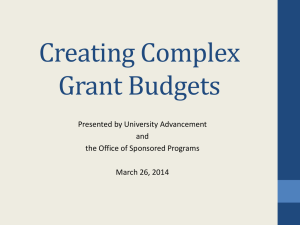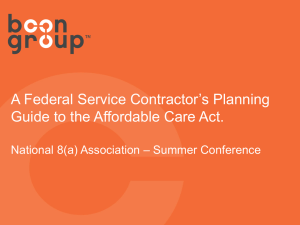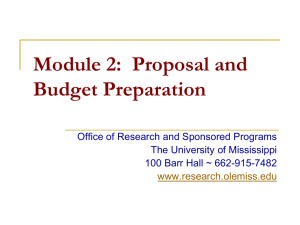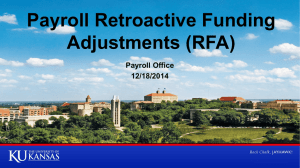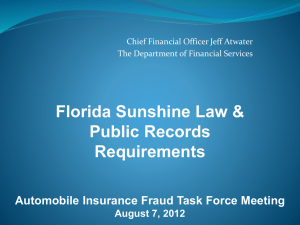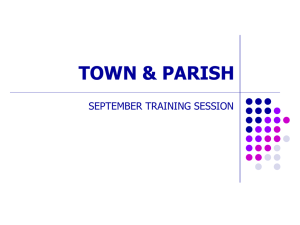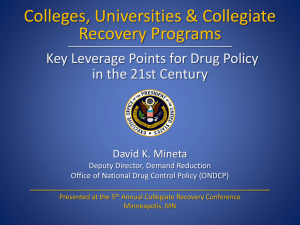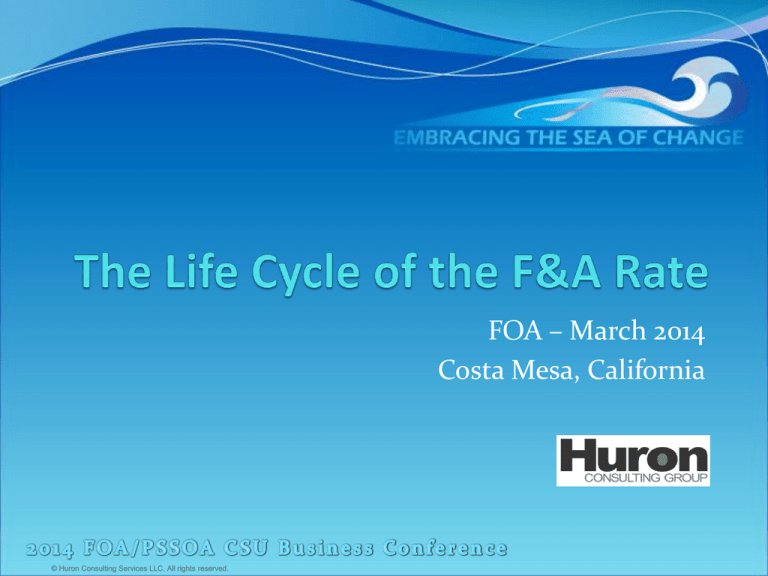
FOA – March 2014
Costa Mesa, California
© Huron Consulting Services LLC. All rights reserved.
Faculty
Paul Nacon – Senior Director, Huron Consulting Group
Chicago, IL and Henderson, NV
Paul has more than 40 years of experience in auditing, accounting, and management
consulting with a heavy emphasis on facilities and administrative costs. He has
established a professional presence in the higher education and non-profit organization
grantee research community. Paul is recognized by professional organizations and peer
groups as a national expert in cost allocation and federal compliance. Prior to joining
Huron, Paul was the National Director for the Division of Cost Allocation with the U.S.
Department of Health and Human Services in Washington DC. He has written several
published articles on indirect costs and is a contributing author to a book published by
Jones and Bartlett titled Research Administration and Management. Paul is an SRA
Distinguished Faculty member, is the recipient of numerous awards and is a past
President for the Western Section.
Email: pnacon@huronconsultinggroup.com
Cell Phone: 312.804.9293
2
Presenter
Nick Schulte – Manager, Huron Consulting Group
Sacramento, CA
Nick has over 10 years of experience related to federal regulations and compliance, both
in a consulting and an auditing capacity. His experience working with universities,
hospitals and not-for-profit organizations has provided him a strong background in
fringe benefit rate development, indirect cost rate development, cost allocation
methodology, performance improvement assistance, as well as conducting compliance
and performance audits.
He has worked extensively with the University of California on their system-wide fringe
benefit rate implementation project.
Email: nschulte@huronconsultinggroup.com
Cell Phone: 530.902.7812
3
The Life Cycle of the F&A Rate
What We Will Cover
The F&A Rate Proposal
Rate Development
Long Form
Short Form
Rate Submission
Long Form
Short Form
Rate Negotiation
Long Form
Short Form
Rate Application
F&A Revenue Distribution
4
The Life Cycle of the F&A Rate
What We Will Cover
(continued)
Base Year Suggestions
Pooled (Composite) Fringe Benefit Rates
5
The Proposal
The financial and statistical documentation and narrative descriptions
that are gathered and developed in support of the institutions Facilities
and Administrative (F&A) cost rate.
Must comply with the federal cost principles contained on 2CFR, Part
220 (formerly OMB Circular A-21).
The proposal is submitted to either the Department of Human Services
(DHHS), Division of Cost Allocation(DCA) or the Department of
Defense (DOD), Office of Naval Research (ONR).
The cognizant federal agency for all of the California State Colleges and
Universities is DHHS – DCA.
6
Rate Development
Long Form
A complicated process that can take 6 to 9 months to complete
Many universities bring in outside firms to develop and negotiate the
proposal
Requires space use survey if not using default methodology
Requires a special library user survey if not using default methodology
Requires the development of a direct charge equivalent (DCE) for academic
departments for the departmental administration (DA) cost pool
Requires the development of at least 7 indirect cost pools with individual
allocation bases. Many institutions sub-pool for a more discreet allocations
Institutions usually develop 3 rates; an Organized Research (OR) rate, an
Other Sponsored Activities (OSA) rate and an Instruction rate. All of these
usually have both on-campus and off-campus rates.
Special rates may also be proposed and negotiated
7
Rate Development
Short Form
A formula driven calculation that takes much less time to complete
Can be developed in house using institutional financial statements, but
many institutions still bring in outside assistance
Does not require a space use survey
Does not require a library user survey
Does not require the development of a direct charge equivalent (DCE)
Requires the development of one indirect cost pool and one allocation
base.
Results in one indirect cost rate applicable to all activities. Some
institutions have off campus rates – but not all
8
Rate Submission
Long Form
A large volume of financial and statistical data is submitted to support the
proposed F&A rate calculation. For very large institutions, can be multiple
binders. What should be submitted?
A cover letter
An indirect cost proposal check list
An F&A rate certification
An assurance statement for depreciation (if applicable)
The standard format
Indirect cost rate calculations for OR, OSA and Instruction (on and off campus)
A narrative description for each cost pool
A schedule identifying the costs assigned to each cost pool
A narrative description for each cost pool allocation base
A schedule showing how each cost pool is distributed
Continued
9
Rate Submission
Long Form
What should be submitted? (continued)
A reconciliation schedule to the financial statements
An adjustment schedule
A step-down schedule
An example of the DCE formula and calculation
A copy of the space survey instructions and training materials
A calculation of future facility costs for new research buildings if applicable
10
Rate Submission
Short Form
Generally results in a document that does not initially exceed 10 pages.
What should be submitted?
A cover letter
The rate calculation
An F&A rate certification
An F&A proposal checklist
A spreadsheet reconciling to the financial statements showing
reclassifications and adjustments to FS financial data
Notes to the reconciliation and adjustment schedule explaining
reclassifications and adjustments
A worksheet that documents the salaries documented as DA
A worksheet that shows space for academic activities versus other
institutional activities to support adjustment to space related costs
11
Rate Negotiation
Long Form
May take up to six months or more for the review to start and over one
year for negotiations to conclude
Depending on the federal research dollars (over $25 million), may
require a site visit
DCA will usually focus on the space related cost pools since the
administrative cost pools are capped at 26 points (space survey is
always reviewed and seldom accepted)
Negotiations are generally more formal and could be in person, but
usually can be accomplished over the phone or via email
Rates are usually negotiated on a predetermined basis for 3 to 5 years
12
Rate Negotiation
Short Form
May take up to six months or more for the review to start, but once
started, can conclude quickly
Almost never involves a site visit
DCA will usually make sure all unallowable costs and activities have
been properly treated
DCA will also look to make sure required adjustments have been made
for OIA activities
Negotiations are usually conducted over the phone and via email
Rates are usually negotiated on a predetermined basis for 3 to 5 years
13
F&A Revenue Distribution
Everyone is different
All or most of the F&A revenue goes to the General Fund
All or most of the F&A revenue goes to Central Administration
Most of the F&A revenue goes to the VP Research
F&A revenue can be split between Central Administration and the Deans
All or most of the F&A revenue goes to the Deans
All or most of the F&A revenue goes to Department Chairs
Policy mandates return to the Principle Investigators (left up to Deans and
Department Chairs)
14
Base Year Suggestions
Plan early
What do you want to do? Are you OK with current rate? Requests for
rate extensions are now permitted with DCA approval.
Identify the operating departments and academic units that will be
involved for obtaining financial and / or statistical information.
Keep detail related to year-end GAAP adjustments so that department
level information is available to categorize the adjustments into the
appropriate cost pools for the F&A rate
15
Base Year Suggestions
Determine if space survey will be used.
Full survey or alternate space survey
Identify academic departments to be surveyed
Develop instructions and training materials
Conduct training and initiate space survey
Obtain employee classification titles from human resources for DCE
calculation
16
For
California State Universities
Agenda
Advantages of Implementing a Fringe Benefit Rate
CSU System Advantages
UC System Experience
Critical Decision Factors
Fringe Benefit Rate Implementation Approach
18
Advantages of a Fringe Benefit Rate
Increased Recovery:
A fringe benefit rate will allow your institution to recover costs that
are not currently distributed as direct costs to sponsored projects
You can likely increase cost recovery by implementing
comprehensive fringe benefit rates
Fringe benefits that are funded by central administration are only
partially recovered through the facilities and administrative cost
rate
A fringe benefit rate will allow you to further increase recovery by
directly charging full fringe benefits to auxiliary operations
19
Advantages of a Fringe Benefit Rate
Increased Efficiency:
A fringe benefit rate will pool fringe benefit costs and will distribute
total costs to benefiting departments, sponsored projects, and other
cost objectives
One charge for fringe benefits instead of many charges for individual
benefits (FICA, retirement, health insurance, etc.)
A fringe benefit rate will allow for easier recordkeeping and less
maintenance of benefits and costs of programs for employees
A fringe benefit rate will simplify the following processes:
The monitoring of fringe benefit charges to departments, grants, and
contracts
Billing for grants and contracts
Salary transfers
20
Advantages of a Fringe Benefit Rate
Easier Budgeting:
A comprehensive fringe benefit rate can be used to budget
sponsored projects and departmental expenditures
A fringe benefit rate will simplify budget negotiations with sponsors
The same fringe benefit rate will be used for budgeting and
charging purposes
Variances between budget and actual costs for grants, contracts,
and departmental budgets will be decreased
21
Advantages of a Fringe Benefit Rate
Reduced Risk of Non-Compliance:
Fringe Benefit Rates require annual calculation of actual costs to
charged benefits
Over/under is included in future year rate calculations that are
agreed upon by the federal government
Opportunities for unallowable/unallocable fringe benefit costs
being charged to federal sources is decreased
22
CSU System Rate Advantages
Single calculation and negotiation
• System-wide calculation and negotiation of rates
• Reduced campus administrative burden
• Establish a single set of guidelines
• Consistent with how benefits are negotiated and paid
• Having Chancellors Office determine issues may simplify
the implementation at a campus
• Simplify final results (fewer categories)
• Minimize some of the labor distribution programming
23
UC System Experience
Initial Project Background
• University of California has 10 campuses plus the Office of the
•
•
•
•
•
President (UCOP) and the Agriculture and Natural Resources (ANR)
division - 5 campuses with Schools of Medicine
The UC system made the decision to implement a system-wide
negotiated methodology for fringe benefits rates that would coincide
with the go-live dates of the new payroll system (UCPath)
The plan was to implement UCPath in 3 waves
UC Davis and UC Berkeley switched to fringe benefit rates prior to
the UC system methodology implementation
Steering Committee created that comprised of members from most
of the campuses to guide the project
Initial discussions included system-wide rates and either a single
rate or 2-3 rate categories
24
UC System Experience
Project Developments and Experience
• UCPath implementation has moved dates multiple times
• Current methodology includes 6-8 rate categories at each of the 10
campuses plus UCOP and ANR
•
Currently working with some of the individual campuses to modify this
methodology which may potentially increase the rate categories
• Many interested parties with different goals
•
•
•
•
10 Universities
University Administration
University Faculty
Federal Government
• Unique issues with University of California that DCA has not dealt
with at other universities
25
Critical Decision Factors
• Approval from DCA for system rates
•
Implementing rates at beginning of fiscal year vs. mid-fiscal year
•
Implementing different campuses at different points in time
• Number of rates and approach to fringe rates
•
•
Use of salary bands
Benefits received
•
•
Fulltime / Part time
Staff categories
• Inclusion of campus based benefit cost
•
•
Sabbaticals
Termination pay
•
•
Employee Tuition
Institution Specific contracts
• Flexibility allowed to individual campuses
• Accommodating individual campus differences
•
•
Research intensive campuses
Salary differentials
• Determine the impact to each institution
26
Fringe Benefit Rate Implementation Approach
Internal Communication, Preparation, and Discussion
Step 1:
System
Approach
Step 2:
DCA
Agreement
Step 3:
Rate
Development
Step 4:
Impact
Analysis
Step 5:
Proposal
Development &
Submission
Step 6:
Implement
System
Changes
Step 7:
Rollout
Fringe
Rate
.
.
External Communication/Negotiation with Federal Government
Step 1: System Approach
•
•
•
Determine the approach for the California State University System
Develop an implementation plan
Conduct high level rate development and impact analysis
Step 2: DCA Agreement
•
•
Prepare financial modeling for DCA
Propose approach to DCA (potential staggered and/or midyear implementation plan)
27
Fringe Benefit Rate Implementation Approach
Internal Communication, Preparation, and Discussion
Step 1:
System
Approach
Step 2:
DCA
Agreement
Step 4:
Impact
Analysis
Step 3:
Rate
Development
Step 5:
Proposal
Development &
Submission
Step 6:
Implement
System
Changes
Step 7:
Rollout
Fringe
Rate
.
External Communication/Negotiation with Federal Government
Step 3: Rate Development
•
•
•
Determine the programs to be included in the fringe benefit rate calculation
Develop fringe benefit rate categories (faculty, staff, etc.)
Develop allocation methodology and cost model
Step 4: Impact Analysis
•
Determine cost recovery impact to individual campuses, funding sources, and departments
within campuses
Step 5: Proposal Development and Submission
•
Prepare proposal for campuses including DS-2 amendments
28
Fringe Benefit Rate Implementation Approach
Internal Communication, Preparation, and Discussion
Step 1:
System
Approach
Step 2:
DCA
Agreement
Step 3:
Rate
Development
Step 4:
Impact
Analysis
Step 5:
Proposal
Development &
Submission
Step 6:
Implement
System
Changes
Step 7:
Rollout
Fringe
Rate
External Communication/Negotiation with Federal Government
Step 6: Implement System Changes
•
•
•
Revise payroll and labor distribution systems to apply fringe benefit rate
Create new accounts/object codes in General Ledger to account for fringe benefit costs and
allocations
Test systems to ensure accuracy of system changes
Step 7: Rollout Fringe Rate
•
•
•
Develop fringe benefit rate rollout plan for campuses
Executive leadership and faculty communication
Administrator training
29

